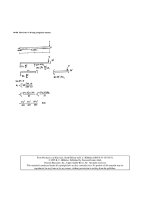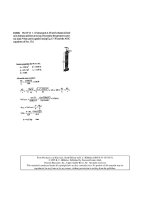Engineering Mechanics - Statics Episode 3 Part 8 pdf
Bạn đang xem bản rút gọn của tài liệu. Xem và tải ngay bản đầy đủ của tài liệu tại đây (543.84 KB, 39 trang )
Engineering Mechanics - Statics Chapter 11
Problem 11-9
A force
P
is applied to the end of the
lever. Determine the horizontal force
F
on the piston for equilibrium.
Solution:
δ
s 2 l
δθ
=
x 2 l cos
θ
()
=
δ
x 2− l sin
θ
()
δθ
=
δ
UP−
δ
sF
δ
x−= 0=
P− 2l
δθ
F2lsin
θ
()
δθ
+ 0=
FPcsc
θ
()
=
Problem 11-10
The mechanism consists of the four pin-connected bars and three springs, each having a stiffness k
and an unstretched length l
0
Determine the horizontal forces
P
that must be applied to the pins in order
to hold the mechanism in the horizontal position for equilibrium.
1081
© 2007 R. C. Hibbeler. Published by Pearson Education, Inc., Upper Saddle River, NJ. All rights reserved.
This material is protected under all copyright laws as they currently exist. No portion of this material may
be reproduced, in any form or by any means, without permission in writing from the publisher.
Engineering Mechanics - Statics Chapter 11
Solution:
xlcos
θ
()
=
δ
xl− sin
θ
()
δθ
=
y 2 l sin
θ
()
=
δ
y 2 l cos
θ
()
δθ
=
δ
U = 0;
2− P
δ
x 3 F
s
− 0=
2 Plsin
θ
()
δθ
3 F
s
2lcos
θ
()
δθ
− 0=
P sin
θ
()
3 F
s
cos
θ
()
=
Since
F
s
k 2 lsin
θ
()
l
0
−
()
=
,
then
P 3 kcot
θ
()
2 lsin
θ
()
l
0
−
()
=
Problem 11-11
When
θ
=
θ
0
, the uniform block of weight W
b
compresses the two vertical springs a distance
δ
. If
the uniform links AB and CD each weigh W
L
, determine the magnitude of the applied couple
moments
M
needed to maintain equilibrium.
1082
© 2007 R. C. Hibbeler. Published by Pearson Education, Inc., Upper Saddle River, NJ. All rights reserved.
This material is protected under all copyright laws as they currently exist. No portion of this material may
be reproduced, in any form or by any means, without permission in writing from the publisher.
Engineering Mechanics - Statics Chapter 11
Given:
θ
0
20 deg= a 1ft=
W
b
50 lb= b 4ft=
δ
4in= c 1ft=
W
L
10 lb= d 2ft=
k 2
lb
in
=
Solution:
θθ
0
=
y
1
b
2
cos
θ
()
=
δ
y
1
b−
2
sin
θ
()
δθ
=
y
2
a
2
bcos
θ
()
+=
δ
y
2
b− sin
θ
()
δθ
=
y
3
y
2
a
2
+=
δ
y
3
δ
y
2
=
δ
U 2− W
L
δ
y
1
W
b
δ
y
2
− 2k
δδ
y
3
− 2M
δθ
−= 0=
δ
U 2W
L
b
2
⎛
⎜
⎝
⎞
⎟
⎠
sin
θ
()
W
b
bsin
θ
()
+ 2k
δ
bsin
θ
()
+ 2M−
⎡
⎢
⎣
⎤
⎥
⎦
δθ
= 0=
M
W
L
W
b
+
2
⎛
⎜
⎝
⎞
⎟
⎠
bk
δ
b+
⎡
⎢
⎣
⎤
⎥
⎦
sin
θ
()
= M 52.0 lb ft⋅=
Problem 11-12
The spring is unstretched when
θ
= 0. Determine the angle
θ
for equilibrium. Due to the roller
guide, the spring always remains vertical. Neglect the weight of the links.
1083
© 2007 R. C. Hibbeler. Published by Pearson Education, Inc., Upper Saddle River, NJ. All rights reserved.
This material is protected under all copyright laws as they currently exist. No portion of this material may
be reproduced, in any form or by any means, without permission in writing from the publisher.
Engineering Mechanics - Statics Chapter 11
Given:
P 8lb=
k 50
lb
ft
=
a 2ft=
b 2ft=
Solution:
y
1
asin
θ
()
=
δ
y
1
acos
θ
()
δθ
=
y
2
ab+( )sin
θ
()
a+ b+=
δ
y
2
ab+( )cos
θ
()
δθ
=
δ
Uk− y
1
δ
y
1
P
δ
y
2
+= k− asin
θ
()
acos
θ
()
Pa b+( ) cos
θ
()
+
⎡
⎣
⎤
⎦
δθ
= 0=
cos
θ
()
Pa b+()ka
2
sin
θ
()
−
⎡
⎣
⎤
⎦
0=
There are 2 answers
θ
1
acos 0()=
θ
1
90deg=
θ
2
asin
Pa b+()
ka
2
⎡
⎢
⎣
⎤
⎥
⎦
=
θ
2
9.207 deg=
Problem 11-13
Determine the force
P
required to lift the block of mass M using the differential hoist. The lever arm is
fixed to the upper pulley and turns with it.
Given:
a 800 mm=
1084
© 2007 R. C. Hibbeler. Published by Pearson Education, Inc., Upper Saddle River, NJ. All rights reserved.
This material is protected under all copyright laws as they currently exist. No portion of this material may
be reproduced, in any form or by any means, without permission in writing from the publisher.
Engineering Mechanics - Statics Chapter 11
M 15 kg=
b 150 mm=
c 300 mm=
g 9.81
m
s
2
=
Solution:
δ
U = 0;
Pa
δθ
Mg
2
c−
δθ
b
δθ
+
()
+ 0=
Pa
Mg
2
bc−()+ 0=
P
Mg
2
cb−
a
⎛
⎜
⎝
⎞
⎟
⎠
=
P 13.8 N=
Problem 11-14
Determine the magnitude of the applied couple moments
M
needed to maintain equilibrium at
θ
.
The
plate E has a weight W. Neglect the weight of the links AB and CD.
Given:
a 0.5 ft=
d 2ft=
b 1ft=
c 2ft=
W 50 lb=
θ
20 deg=
1085
© 2007 R. C. Hibbeler. Published by Pearson Education, Inc., Upper Saddle River, NJ. All rights reserved.
This material is protected under all copyright laws as they currently exist. No portion of this material may
be reproduced, in any form or by any means, without permission in writing from the publisher.
Engineering Mechanics - Statics Chapter 11
Solution:
y
m
d cos
θ
()
a
2
+=
δ
y
m
d− sin
θ
()
δθ
=
δ
U 2− M
δθ
Wd− sin
θ
()
δθ
()
⎡
⎣
⎤
⎦
−= Wdsin
θ
()
2 M−
()
δθ
= 0=
M
1
2
Wdsin
θ
()
=
M 17.1 lb ft⋅=
Problem 11-15
The members of the mechanism are pin connected. If a horizontal force
P
acts at A, determine the
angle
θ
for equilibrium.The spring is unstretched when
θ
= 90°.
Units Used:
kN 10
3
N=
Given:
a 0.5 m=
k 20
kN
m
=
P 400 N=
Solution:
x
1
acos
θ
()
=
δ
x
1
a− sin
θ
()
δθ
=
x
2
5acos
θ
()
=
δx
2
5− asin θ
()
δθ=
δ
UP5− asin
θ
()()
kacos
θ
()
a− sin
θ
()()
−
⎡
⎣
⎤
⎦
δθ
= 0=
sin
θ
()
5− Pkacos
θ
()
+
()
0=
1086
© 2007 R. C. Hibbeler. Published by Pearson Education, Inc., Upper Saddle River, NJ. All rights reserved.
This material is protected under all copyright laws as they currently exist. No portion of this material may
be reproduced, in any form or by any means, without permission in writing from the publisher.
Engineering Mechanics - Statics Chapter 11
There are 2 equilibrium angles.
θ
1
asin 0()=
θ
1
0deg=
θ
2
acos
5P
ka
⎛
⎜
⎝
⎞
⎟
⎠
=
θ
2
78.5 deg=
Problem 11-16
Determine the force F needed to lift the block having weight W. Hint: Note that the coordinates
S
A
and S
B
can be related to the constant vertical length l of the cord.
Given:
W 100 lb=
Solution:
ls
A
2 s
B
+=
0
δ
s
A
2
δ
s
B
+=
δ
s
A
2−
δ
s
B
=
δ
UF
δ
s
A
W
δ
s
B
+= 2− FW+()
δ
s
B
= 0=
F
W
2
= F 50lb=
1087
© 2007 R. C. Hibbeler. Published by Pearson Education, Inc., Upper Saddle River, NJ. All rights reserved.
This material is protected under all copyright laws as they currently exist. No portion of this material may
be reproduced, in any form or by any means, without permission in writing from the publisher.
Engineering Mechanics - Statics Chapter 11
Problem 11-17
Each member of the pin-connected mechanism has a
mass m
1
. If the spring is unstretched when
θ
= 0°
determine the angle
θ
for equilibrium.
Given:
a 300 mm=
k 2500
N
m
=
m
1
8kg=
M 50 N m⋅=
Solution:
xasin
θ
()
=
δ
xacos
θ
()
δθ
=
yacos
θ
()
=
δ
ya− sin
θ
()
δθ
=
F
s
kx= F
s
kasin
θ
()
=
δ
Um
1
g 2
δ
y
2
⎛
⎜
⎝
⎞
⎟
⎠
δ
y+
⎡
⎢
⎣
⎤
⎥
⎦
F
s
δ
x− M
δθ
+= 0=
δ
U 2− m
1
gasin
θ
()
kasin
θ
()
acos
θ
()
− M+
()
δ
U= 0=
Initial Guesses:
θ
10 deg=
Given
2− m
1
gasin
θ
()
kasin
θ
()
acos
θ
()
− M+ 0=
θ
Find
θ
()
=
θ
10.7 deg=
Now starting with a different guess we find anothe answer.
θ
90 deg=
Given
2− m
1
gasin
θ
()
kasin
θ
()
acos
θ
()
− M+ 0=
θ
Find
θ
()
=
θ
89.3 deg=
1088
© 2007 R. C. Hibbeler. Published by Pearson Education, Inc., Upper Saddle River, NJ. All rights reserved.
This material is protected under all copyright laws as they currently exist. No portion of this material may
be reproduced, in any form or by any means, without permission in writing from the publisher.
Engineering Mechanics - Statics Chapter 11
Problem 11-18
The bar is supported by the spring
and smooth collar that allows the
spring to be always perpendicular to
the bar for any angle
θ
.
If the
unstretched length of the spring is l
0
,
determine the force
P
needed to hold
the bar in the equilibrium position
θ
.
Neglect the weight of the bar.
Solution:
sasin
θ
()
=
δ
s
acos
θ
()
δθ
=
ylsin
θ
()
=
δ
y
lcos
θ
()
δθ
=
F
s
kasin
θ
()
l
0
−
()
=
δ
UP
δ
yF
s
δ
s−= 0=
δ
UPlcos
θ
()
δθ
kasin
θ
()
l
0
−
()
acos
θ
()
δθ
−= 0=
P
ka
l
asin
θ
()
l
0
−
()
=
Problem 11-19
The scissors jack supports a load
P
. Determine the axial force in the screw necessary for
equilibrium when the jack is in the position
θ
. Each of the four links has a length L and is
pin-connected at its center. Points B and D can move horizontally.
1089
© 2007 R. C. Hibbeler. Published by Pearson Education, Inc., Upper Saddle River, NJ. All rights reserved.
This material is protected under all copyright laws as they currently exist. No portion of this material may
be reproduced, in any form or by any means, without permission in writing from the publisher.
Engineering Mechanics - Statics Chapter 11
Solution:
xLcos
θ
()
=
δ
xL− sin
θ
()
δθ
=
y 2L sin
θ
()
=
δ
y 2L cos
θ
()
δθ
=
δ
UP−
δ
yF
δ
x−= P− 2Lcos
θ
()
FLsin
θ
()
+
()
δθ
= 0= F 2P cot
θ
()
=
Problem 11-20
Determine the masses m
A
and m
B
of A and B required to hold the desk lamp of mass M in balance for
any angles
θ
and
φ
. Neglect the weight of the mechanism and the size of the lamp.
Given:
M 400 gm=
a 75 mm=
b 75 mm=
c 75 mm=
d 300 mm=
e 300 mm=
g 9.81
m
s
2
=
1090
© 2007 R. C. Hibbeler. Published by Pearson Education, Inc., Upper Saddle River, NJ. All rights reserved.
This material is protected under all copyright laws as they currently exist. No portion of this material may
be reproduced, in any form or by any means, without permission in writing from the publisher.
Engineering Mechanics - Statics Chapter 11
y
1
be+( )sin
θ
()
dsin
φ
()
−=
δ
y
1
be+( )cos θ
(
)
δθ dcos φ
()
δφ−=
y
2
bsin
θ
()
csin
φ
()
+ asin
θ
()
−=
δ
y
2
ba−( )cos
θ
()
δθ
ccos
φ
()
δφ
+=
y
3
a− sin
θ
()
=
δ
y
3
a− cos
θ
()
δθ
=
δ
UM− g
δ
y
1
m
A
g
δ
y
2
− m
B
g
δ
y
2
−= 0=
δ
UgM− be+()m
A
ba−()− m
B
a+
⎡
⎣
⎤
⎦
cos
θ
()
δθ
Md m
A
c−
()
cos
φ
()
δφ
+
⎡
⎣
⎤
⎦
= 0=
We now solve by setting both coefficients to zero.
Guesses m
A
1kg= m
B
1kg=
Given M− be+()m
A
ba−()− m
B
a+ 0= Md m
A
c− 0=
m
A
m
B
⎛
⎜
⎝
⎞
⎟
⎠
Find m
A
m
B
,
()
=
m
A
m
B
⎛
⎜
⎝
⎞
⎟
⎠
1.6
2
⎛
⎜
⎝
⎞
⎟
⎠
kg=
Problem 11-21
The Roberval balance is in equilibrium when no weights are placed on the pans A and B. If two
masses m
A
and m
B
are placed at any location a and b on the pans, show that equilibrium is maintained
if m
A
d
A
= m
B
d
B
.
Solution:
y
A
d
A
sin
θ
()
=
δ
y
A
d
A
cos
θ
()
δθ
=
y
B
d
B
− sin
θ
()
=
δ
y
B
d
B
− cos
θ
()
δθ
=
δ
Um
A
− gd
A
cos
θ
()
δθ
m
B
gd
B
− cos
θ
()
()
δθ
−= 0=
1091
Solution:
© 2007 R. C. Hibbeler. Published by Pearson Education, Inc., Upper Saddle River, NJ. All rights reserved.
This material is protected under all copyright laws as they currently exist. No portion of this material may
be reproduced, in any form or by any means, without permission in writing from the publisher.
Engineering Mechanics - Statics Chapter 11
δ
Um
B
d
B
m
A
d
A
−
()
gcos
θ
()
δθ
= 0=
m
A
d
A
m
B
d
B
=
Q.E.D
Problem 11-22
The chain puller is used to draw two ends of a chain together in order to attach the “master link.” The
device is operated by turning the screw S, which pushes the bar AB downward, thereby drawing the
tips C and D towards one another. If the sliding contacts at A and B are smooth, determine the force
F
maintained by the screw at E which is required to develop a drawing tension
T
in the chains.
Given:
T =120 lb
1092
© 2007 R. C. Hibbeler. Published by Pearson Education, Inc., Upper Saddle River, NJ. All rights reserved.
This material is protected under all copyright laws as they currently exist. No portion of this material may
be reproduced, in any form or by any means, without permission in writing from the publisher.
Engineering Mechanics - Statics Chapter 11
θ
60 deg=
a 3in=
b 1in=
Solution:
δ
s
b
δθ
cos
θ
()
=
δ
y
b
cos
θ
()
⎛
⎜
⎝
⎞
⎟
⎠
1
sin
θ
()
⎛
⎜
⎝
⎞
⎟
⎠
δθ
=
δ
U 0=
F
δ
y 2Ta
δθ
()
− 0=
Fb
cos
θ
()
sin
θ
()
2 Ta=
F 2 Tacos
θ
()
sin
θ
()
b
⎛
⎜
⎝
⎞
⎟
⎠
=
F 312lb=
Problem 11-23
The service window at a fast-food restaurant consists of glass doors that open and close automatically
using a motor which supplies a torque
M
to each door. The far ends, A and B, move along the
horizontal guides. If a food tray becomes stuck between the doors as shown, determine the horizontal
force the doors exert on the tray at the position
θ
.
Solution:
x 2acos θ
()
=
1093
© 2007 R. C. Hibbeler. Published by Pearson Education, Inc., Upper Saddle River, NJ. All rights reserved.
This material is protected under all copyright laws as they currently exist. No portion of this material may
be reproduced, in any form or by any means, without permission in writing from the publisher.
Engineering Mechanics - Statics Chapter 11
δ
x 2− asin
θ
()
δθ
=
δ
U
=
0;
M−
δθ
F
δ
x− 0=
M−
δθ
F 2 a sin
θ
()
δθ
+ 0=
F
M
2 a sin
θ
()
=
Problem 11-24
A horizontal force acts on the end of
the link as shown. Determine the
angles
θ
1
and
θ
2
for equilibrium of
the two links. Each link is uniform
and has a mass m.
Solution:
xlsin
θ
1
()
lsin
θ
2
()
+=
y
1
l
2
cos
θ
1
()
=
y
2
lcos
θ
1
()
l
2
cos
θ
2
()
+=
δ
xlcos
θ
1
()
δθ
1
lcos
θ
2
()
δθ
2
+=
δ
y
1
l
2
− sin
θ
1
()
δθ
1
=
δ
y
2
l− sin
θ
1
()
δθ
1
l
2
sin
θ
2
()
δθ
2
−=
δ
UP
δ
x
mg
δ
y
1
+ mg
δ
y
2
+= 0=
δ
UPlcos
θ
1
()
δθ
1
cos
θ
2
()
δθ
2
+
()
mg
l
2
⎛
⎜
⎝
⎞
⎟
⎠
3sin
θ
1
()
δθ
1
sin
θ
2
()
δθ
2
+
()
−= 0=
1094
© 2007 R. C. Hibbeler. Published by Pearson Education, Inc., Upper Saddle River, NJ. All rights reserved.
This material is protected under all copyright laws as they currently exist. No portion of this material may
be reproduced, in any form or by any means, without permission in writing from the publisher.
Engineering Mechanics - Statics Chapter 11
δ
UPlcos
θ
1
()
3
2
mglsin
θ
1
()
−
⎛
⎜
⎝
⎞
⎟
⎠
δθ
1
Plcos
θ
2
()
1
2
mglsin
θ
2
()
−
⎛
⎜
⎝
⎞
⎟
⎠
δθ
2
+= 0=
Thus we have 2 equations:
Plcos
θ
1
()
3
2
mglsin
θ
1
()
− 0=
θ
1
atan
2 P
3 mg
⎛
⎜
⎝
⎞
⎟
⎠
=
Plcos
θ
2
()
1
2
mglsin
θ
2
()
− 0=
θ
2
atan
2 P
mg
⎛
⎜
⎝
⎞
⎟
⎠
=
Problem 11-25
Rods AB and BC have centers of
mass located at their midpoints. If all
contacting surfaces are smooth and
BC has mass m
BC
determine the
appropriate mass m
AB
of AB required
for equilibrium.
Given:
m
BC
100 kg=
a 0.75 m=
b 1m=
c 2m=
d 1.5 m=
Solution:
Use
θ
as the independent variable
Define L
1
a
2
b
2
+= L
2
c
2
d
2
+=
θ
atan
d
c
⎛
⎜
⎝
⎞
⎟
⎠
=
φ
atan
a
b
⎛
⎜
⎝
⎞
⎟
⎠
=
Then L
1
cos
φ
()
L
2
cos
θ
()
+ bc+= L
1
− sin
φ
()
δφ
L
2
sin
θ
()
δθ
− 0=
1095
© 2007 R. C. Hibbeler. Published by Pearson Education, Inc., Upper Saddle River, NJ. All rights reserved.
This material is protected under all copyright laws as they currently exist. No portion of this material may
be reproduced, in any form or by any means, without permission in writing from the publisher.
Engineering Mechanics - Statics Chapter 11
Thus
δφ
L
2
sin
θ
()
L
1
sin
φ
()
⎛
⎜
⎝
⎞
⎟
⎠
δθ
=
Also y
1
L
1
2
sin
φ
()
=
δ
y
1
L
1
2
cos
φ
()
δφ
=
L
2
− sin
θ
()
cot
φ
()
2
⎛
⎜
⎝
⎞
⎟
⎠
δθ
=
y
2
L
2
2
sin
θ
()
=
δ
y
2
L
2
2
cos
θ
()
δθ
=
δ
Um
AB
− g
δ
y
1
m
BC
g
δ
y
2
−= gm
AB
L
2
sin
θ
()
cot
φ
()
2
⎛
⎜
⎝
⎞
⎟
⎠
m
BC
L
2
2
cos
θ
()
⎛
⎜
⎝
⎞
⎟
⎠
−
⎡
⎢
⎣
⎤
⎥
⎦
δθ
= 0=
m
AB
m
BC
tan
φ
()
cot
θ
()
= m
AB
100 kg=
Problem 11-26
If the potential energy for a conservative two-degree-of-freedom system is expressed by the
relation V = ay
2
+ bx
2
, where y and x, determine the equilibrium positions and investigate the
stability at each position.
Given:
a 3
N
m
= b 2
N
m
=
Solution:
Vay
2
bx
2
+=
Equilibrium position:
x
V
∂
∂
2bx= 0= x 0=
y
V
∂
∂
2ay= 0= y 0=
Stability:
At
00,()
2
x
V
∂
∂
2
2b= 2b 4
N
m
=
> 0
At
00,()
2
y
V
∂
∂
2
2a= 2a 6
N
m
=
> 0
1096
© 2007 R. C. Hibbeler. Published by Pearson Education, Inc., Upper Saddle River, NJ. All rights reserved.
This material is protected under all copyright laws as they currently exist. No portion of this material may
be reproduced, in any form or by any means, without permission in writing from the publisher.
Engineering Mechanics - Statics Chapter 11
At
00,()
xy
V
∂
∂
∂
∂
0=
At
00,()
xy
V
∂
∂
∂
∂
⎛
⎜
⎝
⎞
⎟
⎠
2
2
x
V
∂
∂
2⎛
⎜
⎜
⎝
⎞
⎟
⎟
⎠
2
y
V
∂
∂
2⎛
⎜
⎜
⎝
⎞
⎟
⎟
⎠
−
⎡
⎢
⎢
⎣
⎤
⎥
⎥
⎦
4− ab= 4− ab 24−
N
2
m
2
=
< 0
Stable at (0,0)
Problem 11-27
If the potential energy for a conservative one-degree-of-freedom system is expressed by the relation
V = (ax
3
+ bx
2
+ cx + d), determine the equilibrium positions and investigate the stability at each
position.
Given:
a 4
lb
ft
2
= b 1−
lb
ft
= c 3− lb= d 10 ft lb⋅=
Solution:
Vax
3
bx
2
+ cx+ d+=
Required Position:
x
V
d
d
3ax
2
2bx+ c+= 0=
x
1
2− b 4b
2
43a()c−+
23a()
=
x
1
0.59 ft=
x
2
2− b 4b
2
43ac()−−
23a()
=
x
2
0.424− ft=
Stability:
2
x
V
d
d
2
V''= 6ax 2b+=
At
xx
1
=
V''
1
6ax
1
2b+= V''
1
12.2
lb
ft
= V''
1
0>
Stable
1097
© 2007 R. C. Hibbeler. Published by Pearson Education, Inc., Upper Saddle River, NJ. All rights reserved.
This material is protected under all copyright laws as they currently exist. No portion of this material may
be reproduced, in any form or by any means, without permission in writing from the publisher.
Engineering Mechanics - Statics Chapter 11
At
xx
2
=
V''
2
6ax
2
2b+= V''
2
12.2−
lb
ft
= V''
2
0<
Unstable
Problem 11-28
If the potential energy for a conservative one-degree-of-freedom system is expressed by the relation V
= asin(
θ) +
bcos
(
2
θ),
0 deg
θ
≤ 180 deg≤
,
determine the equilibrium positions and investigate the
stability at each position.
Given:
a 24 ft lb⋅= b 10 ft lb⋅=
Solution:
Vasin
θ
()
bcos 2
θ
()
+=
θ
V
d
d
V'= acos
θ
()
2bsin 2
θ
()
−= acos
θ
()
4bsin
θ
()
cos
θ
()
−=
V' cos
θ
()
a 4bsin
θ
()
−
()
= 0=
2
x
V
d
d
2
V''= a− sin
θ
()
4bcos 2
θ
()
−=
Equilibirium Positions:
θ
1
acos 0()=
θ
1
90deg=
θ
2
asin
a
4b
⎛
⎜
⎝
⎞
⎟
⎠
=
θ
2
36.87 deg=
θ
3
πθ
2
−=
θ
3
143.13 deg=
Check Stability
V''
1
a− sin
θ
1
()
4bcos 2
θ
1
()
−= V''
1
16lb ft= Stable
V''
2
a− sin
θ
2
()
4bcos 2
θ
2
()
−= V''
2
25.6− lb ft= Unstable
V''
3
a− sin
θ
3
()
4bcos 2
θ
3
()
−= V''
3
25.6− lb ft= Unstable
Problem 11-29
If the potential energy for a conservative two-degree-of-freedom system is expressed by the
relation V = a
y
2
+ bx
2
, where y and x, determine the equilibrium positions and investigate the
1098
© 2007 R. C. Hibbeler. Published by Pearson Education, Inc., Upper Saddle River, NJ. All rights reserved.
This material is protected under all copyright laws as they currently exist. No portion of this material may
be reproduced, in any form or by any means, without permission in writing from the publisher.
Engineering Mechanics - Statics Chapter 11
y
stability at each position.
Given:
a 6
N
m
= b 2
N
m
=
Solution:
Vay
2
bx
2
+=
Equilibrium position:
x
V
∂
∂
2bx= 0= x 0=
y
V
∂
∂
2ay= 0= y 0=
Stability:
At
00,()
2
x
V
∂
∂
2
2b= 2b 4
N
m
=
> 0
At
00,()
2
y
V
∂
∂
2
2a= 2a 12
N
m
=
> 0
At
00,()
xy
V
∂
∂
∂
∂
0=
At
00,()
xy
V
∂
∂
∂
∂
⎛
⎜
⎝
⎞
⎟
⎠
2
2
x
V
∂
∂
2⎛
⎜
⎜
⎝
⎞
⎟
⎟
⎠
2
y
V
∂
∂
2⎛
⎜
⎜
⎝
⎞
⎟
⎟
⎠
−
⎡
⎢
⎢
⎣
⎤
⎥
⎥
⎦
4− ab= 4− ab 48−
N
2
m
2
=
< 0
Stable at (0,0)
Problem 11-30
The spring of the scale has an unstretched length a. Determine the angle
θ
for equilibrium when a
weight W is supported on the platform. Neglect the weight of the members. What value W would be
required to keep the scale in neutral equilibrium when
θ
= 0°?
Solution:
Potential Function:The datum is established at point A. Since the weight W is above the datum, its
potential energy is positive.
1099
© 2007 R. C. Hibbeler. Published by Pearson Education, Inc., Upper Saddle River, NJ. All rights reserved.
This material is protected under all copyright laws as they currently exist. No portion of this material may
be reproduced, in any form or by any means, without permission in writing from the publisher.
Engineering Mechanics - Statics Chapter 11
V
1
2
k 2Lsin
θ
()()
2
W2Lcos
θ
()
+= 2kL
2
sin
θ
()
2
2WLcos
θ
()
+=
Equilibrium Position:The system is in equilibrium if
θ
V
d
d
4kL
2
sin
θ
()
cos
θ
()
2WLsin
θ
()
−= 2Lsin
θ
()
2kLcos
θ
()
W−
()
= 0=
Solving,
θ
0°=
or
θ
acos
W
2kL
⎛
⎜
⎝
⎞
⎟
⎠
=
To have neutral stability at
θ
= 0, we require that
2
θ
V
d
d
2
4kL
2
cos 2 0×()2WLcos 0()−= 4kL
2
2WL−= 0= W 2kL=
Problem 11-31
The two bars each have weight W. Determine the required stiffness k of the spring so that the two
bars are in equilibrium at
θ
=
θ
0
.
The spring has an unstretched length
δ
.
1100
© 2007 R. C. Hibbeler. Published by Pearson Education, Inc., Upper Saddle River, NJ. All rights reserved.
This material is protected under all copyright laws as they currently exist. No portion of this material may
be reproduced, in any form or by any means, without permission in writing from the publisher.
Engineering Mechanics - Statics Chapter 11
Given:
W 8lb=
θ
0
30 deg=
δ
1ft= a 2ft=
Solution:
θθ
0
=
V 2W
a
2
⎛
⎜
⎝
⎞
⎟
⎠
sin
θ
()
1
2
k 2acos
θ
()
δ
−
()
2
+=
dV
d
θ
Wacos
θ
()
k 2acos
θ
()
δ
−
()
2asin
θ
()
−= 0=
k
Wacos
θ
()
2acos
θ
()
δ
−
()
2asin
θ
()
= k 2.812
lb
ft
=
Problem 11-32
Each of the two springs has an
unstretched length
δ
. Determine the mass
M of the cylinder when it is held in the
equilibrium position shown, i.e., y = a.
Given:
a 1m=
b 500 mm=
δ
500 mm=
k 200
N
m
=
1101
© 2007 R. C. Hibbeler. Published by Pearson Education, Inc., Upper Saddle River, NJ. All rights reserved.
This material is protected under all copyright laws as they currently exist. No portion of this material may
be reproduced, in any form or by any means, without permission in writing from the publisher.
Engineering Mechanics - Statics Chapter 11
Solution:
V 2
k
2
y
2
b
2
+
δ
−
()
2
Mgy−=
dV
dy
2ky
2
b
2
+
δ
−
()
y
y
2
b
2
+
⎛
⎜
⎝
⎞
⎟
⎠
Mg−=
Set ya=
Guess M 1kg=
Given
2ky
2
b
2
+
δ
−
()
y
y
2
b
2
+
⎛
⎜
⎝
⎞
⎟
⎠
Mg− 0=
M Find M()= M 22.5 kg=
Problem 11-33
The uniform beam has mass M. If the
contacting surfaces are smooth, determine
the angle
θ
for equilibrium and investigate
the stability of the beam when it is in this
position. The spring has an unstretched
length of
δ
.
Units Used:
kN 10
3
N=
Given:
M 200 kg=
k 1.2
kN
m
=
δ
0.5 m=
l 2m=
Solution:
VMg
l
2
⎛
⎜
⎝
⎞
⎟
⎠
sin
θ
()
1
2
klcos
θ
()
δ
−
()
2
+=
θ
V
d
d
V'= Mg
l
2
⎛
⎜
⎝
⎞
⎟
⎠
cos
θ
()
klcos
θ
()
δ
−
()
lsin
θ
()
−= 0=
2
θ
V
d
d
2
V''= M− g
l
2
⎛
⎜
⎝
⎞
⎟
⎠
sin
θ
()
kl
2
sin
θ
()
2
+ klcos
θ
()
δ
−
()
lcos
θ
()
−=
1102
© 2007 R. C. Hibbeler. Published by Pearson Education, Inc., Upper Saddle River, NJ. All rights reserved.
This material is protected under all copyright laws as they currently exist. No portion of this material may
be reproduced, in any form or by any means, without permission in writing from the publisher.
Engineering Mechanics - Statics Chapter 11
There are 2 equilibrium points
Guess
θ
30 deg= Given Mg
l
2
⎛
⎜
⎝
⎞
⎟
⎠
cos
θ
()
klcos
θ
()
δ
−
()
lsin
θ
()
− 0=
θ
1
Find
θ
()
=
θ
1
36.4 deg=
Guess
θ
60 deg= Given Mg
l
2
⎛
⎜
⎝
⎞
⎟
⎠
cos
θ
()
klcos
θ
()
δ
−
()
lsin
θ
()
− 0=
θ
2
Find
θ
()
=
θ
2
62.3 deg=
Check Stability
V''
1
M− g
l
2
⎛
⎜
⎝
⎞
⎟
⎠
sin
θ
1
()
kl
2
sin
θ
1
()
2
+ klcos
θ
1
()
δ
−
()
lcos
θ
1
()
−=
V''
2
M− g
l
2
⎛
⎜
⎝
⎞
⎟
⎠
sin
θ
2
()
kl
2
sin
θ
2
()
2
+ klcos
θ
2
()
δ
−
()
lcos
θ
2
()
−=
V''
1
1.624− kN m⋅= Unstable V''
2
1.55 kN m⋅= Stable
Problem 11-34
The bar supports a weight W at its end. If the springs are originally unstretched when the bar is
vertical, determine the required stiffness k
1
= k
2
=k of the springs so that the bar is in neutral
equilibrium when it is vertical.
Given:
W 500 lb=
a 3ft=
b 3ft=
c 3ft=
Solution:
VWab+ c+( ) cos
θ
()
1
2
kasin
θ
()()
2
+
1
2
ka b+( )sin
θ
()
⎡
⎣
⎤
⎦
2
+=
θ
V
d
d
W− ab+ c+( ) sin
θ
()
k
2
a
2
ab+()
2
+
⎡
⎣
⎤
⎦
sin 2
θ
()
+=
1103
© 2007 R. C. Hibbeler. Published by Pearson Education, Inc., Upper Saddle River, NJ. All rights reserved.
This material is protected under all copyright laws as they currently exist. No portion of this material may
be reproduced, in any form or by any means, without permission in writing from the publisher.
Engineering Mechanics - Statics Chapter 11
2
θ
V
d
d
2
W− ab+ c+( ) cos
θ
()
ka
2
ab+()
2
+
⎡
⎣
⎤
⎦
cos 2
θ
()
+=
at
θ
0=
2
θ
V
d
d
2
W− ab+ c+()ka
2
ab+()
2
+
⎡
⎣
⎤
⎦
+= 0=
for neutral stabiility
k
Wa b+ c+()
a
2
ab+()
2
+
= k 100
lb
ft
=
Problem 11-35
The uniform rod AB has a mass M. If
spring DC is unstretched at
θ
= 90
deg
,
determine the angle
θ
for equilibrium and
investigate the stability at the equilibrium
position. The spring always acts in the
horizontal position due to the roller guide
at D.
Units Used:
kN 10
3
N=
Given:
M 80 kg= a 1m=
k 2
kN
m
= b 2m=
Solution:
VMg
ab+
2
⎛
⎜
⎝
⎞
⎟
⎠
sin
θ
()
1
2
kacos
θ
()()
2
+=
V'
θ
V
d
d
= Mg
ab+
2
⎛
⎜
⎝
⎞
⎟
⎠
cos
θ
()
k
2
a
2
sin 2
θ
()
−=
V''
2
θ
V
d
d
2
= M− g
ab+
2
⎛
⎜
⎝
⎞
⎟
⎠
sin
θ
()
ka
2
cos 2
θ
()
−=
1104
© 2007 R. C. Hibbeler. Published by Pearson Education, Inc., Upper Saddle River, NJ. All rights reserved.
This material is protected under all copyright laws as they currently exist. No portion of this material may
be reproduced, in any form or by any means, without permission in writing from the publisher.
Engineering Mechanics - Statics Chapter 11
Equilibrium
Guess
θ
30 deg= Given Mg
ab+
2
⎛
⎜
⎝
⎞
⎟
⎠
cos
θ
()
k
2
a
2
sin 2
θ
()
− 0=
θ
1
Find
θ
()
=
Guess
θ
70 deg= Given Mg
ab+
2
⎛
⎜
⎝
⎞
⎟
⎠
cos
θ
()
k
2
a
2
sin 2
θ
()
− 0=
θ
2
Find
θ
()
=
Check Staibility
V''
1
M− g
ab+
2
⎛
⎜
⎝
⎞
⎟
⎠
sin
θ
1
()
ka
2
cos 2
θ
1
()
−=
V''
2
M− g
ab+
2
⎛
⎜
⎝
⎞
⎟
⎠
sin
θ
2
()
ka
2
cos 2
θ
2
()
−=
θ
1
36.1 deg= V''
1
1.3− kN m⋅= Unstable
θ
2
90.0 deg= V''
2
0.82 kN m⋅= Stable
Problem 11-36
Determine the angle
θ
for equilibrium and investigate the stability at this position. The
bars each have mass m
b
and the suspended block D has mass m
D
Cord DC has a total
length of L.
Given:
m
b
3kg=
m
D
7kg=
a 500 mm=
L 1m=
g 9.81
m
s
2
=
Solution:
Equilibrium
V 2m
b
g
a
2
sin
θ
()
m
D
gL a+ 2acos
θ
()
−
()
−= 0=
Vm
b
gasin
θ
()
2m
D
gacos
θ
()
+ m
D
gL a+()−=
1105
© 2007 R. C. Hibbeler. Published by Pearson Education, Inc., Upper Saddle River, NJ. All rights reserved.
This material is protected under all copyright laws as they currently exist. No portion of this material may
be reproduced, in any form or by any means, without permission in writing from the publisher.









